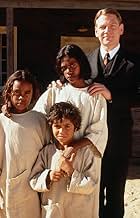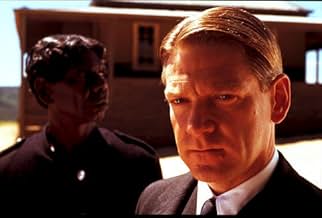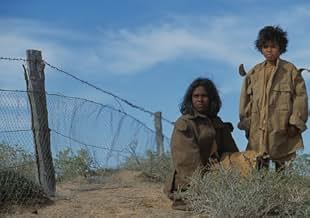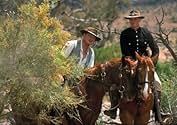VALUTAZIONE IMDb
7,4/10
31.223
LA TUA VALUTAZIONE
Nel 1931, tre ragazze aborigene dopo essere state allontanate con la forza dalle loro case per essere addestrate come domestiche, scappano e si mettono in viaggio attraverso l'Outback.Nel 1931, tre ragazze aborigene dopo essere state allontanate con la forza dalle loro case per essere addestrate come domestiche, scappano e si mettono in viaggio attraverso l'Outback.Nel 1931, tre ragazze aborigene dopo essere state allontanate con la forza dalle loro case per essere addestrate come domestiche, scappano e si mettono in viaggio attraverso l'Outback.
- Regia
- Sceneggiatura
- Star
- Premi
- 23 vittorie e 25 candidature totali
Lorna Lesley
- Miss Thomas
- (as Lorna Leslie)
Recensioni in evidenza
I've seen several movies recently ("Adaptation," "The Hours," "Bowling for Columbine," "City of God," etc.), and "Rabbit-Proof Fence" is the best of the bunch. It's a simple story, but a very moving one. In particular, the performances by the young leads, the beautiful cinematography, and the wise, uncluttered script made this a strong cinematic experience for me. Kenneth Branagh was convincing as the racial purity zealot who manages the whole forced removal scheme. I also really enjoyed the subtle changes we see in the mysterious character of The Tracker (played with wonderfully restrained power by David Gulpilil), as his dogged pursuit of the girls eventually gives way to a dawning admiration. And to cap it all off, the closing real-life footage and text postscript leaves the audience feeling simultaneously devastated and triumphant. Wow.
"And miles to go before I sleep/ And miles to go before I sleep" -- Robert Frost
Set in Western Australia in 1931, Rabbit-Proof Fence, a new film by Australian director Philip Noyce (The Quiet American, Clear and Present Danger), is a scathing attack on the Australian government's "eugenics" policy toward Aboriginal half-castes. Continuing policies begun by the British, the white government in Australia for six decades forcibly removed all half-caste Aborigines from their families "for their own good" and sent them to government camps where they were raised as servants, converted to Christianity, and eventually assimilated into white society.
Based on the 1996 book, "Follow the Rabbit-Proof Fence" by Doris Pilkington Garimara (Molly Kelly's daughter), the film tells the story of three Aboriginal girls, 14-year old Molly Kelley, her 8-year old sister Daisy, and their 10-year old cousin Gracie. It shows their escape from confinement in a government camp for half-castes and their return home across the vast and lonely Australian Outback. It is a simple story of indomitable courage, told with honest emotion. Abducted by police in 1931 from their families at Jigalong, an Aboriginal settlement on the edge of the Little Sandy Desert in northwest Australia, the three girls are sent to the Moore River Native Settlement near Perth. Here the children must endure wretched conditions. Herded into mass dormitories, they are not allowed to speak their native language, are subject to strict discipline, and, if they break the rules, are put into solitary confinement for 14 days.
Followed by the Aborigine tracker, Moodoo (a great performance from David Gulpilil), the girls make their escape. Using a "rabbit-proof fence" as a navigation tool, they walk 1500 miles across the parched Outback to return to Jigalong. The rabbit-proof fence was a strip of barbed-wire netting that cut across half of the continent and was designed to protect farmer's crops by keeping the rabbits away. The girls walked for months on end often without food or drink, not always sure of the direction they are going, using all their ingenuity and intelligence along the way just to survive. The stunning Australian landscape is magnificently photographed by Christopher Doyle, and a haunting score by Peter Gabriel translates natural sounds of birds, animals, wind and rain into music that adds a mystical feeling to the journey.
The performances by amateur actors Evelyn Sampi, Tianna Sansbury, and Laura Monaghan (who had never seen a film before let alone acted in one) are authentic and heartbreakingly affecting. Though the white officials and police are characterized as smug and unfeeling, they are more like bureaucrats carrying out official policies than true villains. Kenneth Branagh gives a strong but restrained performance as Mr. Neville, the minister in charge of half-castes. Rabbit-Proof Fence is an honest film that avoids sentimentality and lets the courage and natural wisdom of the girls shine through. This is one of the best films I've seen this year and has struck a responsive chord in Australia and all over the world. Hopefully, it will become a vehicle for reconciliation, so that the shame of the "Stolen Generation" can at last be held to account.
Set in Western Australia in 1931, Rabbit-Proof Fence, a new film by Australian director Philip Noyce (The Quiet American, Clear and Present Danger), is a scathing attack on the Australian government's "eugenics" policy toward Aboriginal half-castes. Continuing policies begun by the British, the white government in Australia for six decades forcibly removed all half-caste Aborigines from their families "for their own good" and sent them to government camps where they were raised as servants, converted to Christianity, and eventually assimilated into white society.
Based on the 1996 book, "Follow the Rabbit-Proof Fence" by Doris Pilkington Garimara (Molly Kelly's daughter), the film tells the story of three Aboriginal girls, 14-year old Molly Kelley, her 8-year old sister Daisy, and their 10-year old cousin Gracie. It shows their escape from confinement in a government camp for half-castes and their return home across the vast and lonely Australian Outback. It is a simple story of indomitable courage, told with honest emotion. Abducted by police in 1931 from their families at Jigalong, an Aboriginal settlement on the edge of the Little Sandy Desert in northwest Australia, the three girls are sent to the Moore River Native Settlement near Perth. Here the children must endure wretched conditions. Herded into mass dormitories, they are not allowed to speak their native language, are subject to strict discipline, and, if they break the rules, are put into solitary confinement for 14 days.
Followed by the Aborigine tracker, Moodoo (a great performance from David Gulpilil), the girls make their escape. Using a "rabbit-proof fence" as a navigation tool, they walk 1500 miles across the parched Outback to return to Jigalong. The rabbit-proof fence was a strip of barbed-wire netting that cut across half of the continent and was designed to protect farmer's crops by keeping the rabbits away. The girls walked for months on end often without food or drink, not always sure of the direction they are going, using all their ingenuity and intelligence along the way just to survive. The stunning Australian landscape is magnificently photographed by Christopher Doyle, and a haunting score by Peter Gabriel translates natural sounds of birds, animals, wind and rain into music that adds a mystical feeling to the journey.
The performances by amateur actors Evelyn Sampi, Tianna Sansbury, and Laura Monaghan (who had never seen a film before let alone acted in one) are authentic and heartbreakingly affecting. Though the white officials and police are characterized as smug and unfeeling, they are more like bureaucrats carrying out official policies than true villains. Kenneth Branagh gives a strong but restrained performance as Mr. Neville, the minister in charge of half-castes. Rabbit-Proof Fence is an honest film that avoids sentimentality and lets the courage and natural wisdom of the girls shine through. This is one of the best films I've seen this year and has struck a responsive chord in Australia and all over the world. Hopefully, it will become a vehicle for reconciliation, so that the shame of the "Stolen Generation" can at last be held to account.
Official policy between 1910 and 1970 in Australia allowed half-caste Aborigine children to be forcibly removed from their families and incarcerated for their own' good in training schools where their were educated to become fitting servants for white families. This institutionalised eugenics, still recent enough to be remembered by its victims, is still a controversial issue in Australia where the PM John Howard refuses to give an official apology. The film has been doing very well in Australia. The story follows three such girls who are forcibly re-located but escape, and follow the rabbit-proof fence' on a 1500 mile journey back home. The title itself seems to echo not only the yellow brick road of the Wizard of Oz (another journey to reclaim one's wholeness) but the fence that was erected to contain animals which is just how the Aborigine children are treated, albeit with the best intentions. The story was adapted from a book by the daughter of the youngest surviving half-cast Aborigine portrayed in the film the actual child actors had mostly never seen a motion picture before let alone acted in one.
This film has quite a few remarkable features. First of all is its title which is rather unusual and immediately grabs one's interest. Next there is the fence itself which runs for thousands of miles to protect what few green plants there are in these desert regions from the voracious appetites of millions of wild rabbits. This fence plays an important role in this true story. Then there is the diector who not only scoured the continent to find three suitable aboriginal girls to play theleads but moulded these inexperienced beginners into the believable characters of Molly, Daisy and Gracie. The director Phillip Noyce has achieved remarkable success in creating three good little performers and should be given full credit for his difficult task.
For those who do not know the desert regions of Australia, it must be said that the "outback" country is harsh and cruel and can only be crossed by those with experience...those with a knowledge of the land. I think the camera makes it clear that the hostile environment is very much like a fence in itself...almost impossible to cross. All the more remarkable therefore that these girls accomplished what they set out to do. May be it was a reckless decision they made but thanks to the fence they found their way back to family and friends.
The film is largely a record of the long trek and the manner in which the children are able to survive. There are not many dramatic moments on their journey south. The children are mainly concerned with avoiding the blacktracker who is following them. The most unforgettable scene comes early in the film when the children are forcibly torn from their mothers. This is truly heart-wrenching stuff.
This thoughtful presentation is worth watching. It is part of Australian history.
For those who do not know the desert regions of Australia, it must be said that the "outback" country is harsh and cruel and can only be crossed by those with experience...those with a knowledge of the land. I think the camera makes it clear that the hostile environment is very much like a fence in itself...almost impossible to cross. All the more remarkable therefore that these girls accomplished what they set out to do. May be it was a reckless decision they made but thanks to the fence they found their way back to family and friends.
The film is largely a record of the long trek and the manner in which the children are able to survive. There are not many dramatic moments on their journey south. The children are mainly concerned with avoiding the blacktracker who is following them. The most unforgettable scene comes early in the film when the children are forcibly torn from their mothers. This is truly heart-wrenching stuff.
This thoughtful presentation is worth watching. It is part of Australian history.
Yes we've seen children-on-the-run films, but such glib commentary demeans this true life drama and its implications in real life. This magnificent and tragic story is yet another must-see in re:the little holocausts that have gone on, even in the most "civilized" nations - in this case Australia. What a touching story of three girls, marvelously portrayed by unknown young actresses, who escape from a horrific government policy, initiated by white supremacist Australia pre-Hitler and Nazi Germany. It is odd to say this is beautifully filmed in the Australian outback... and Kenneth Brannagh, echoing his recent portrayal as Heydrich in "Conspiracy", plays white evil incarnate - a prim bureaucrat diligently doing his government job's mandate - to cleanse Australia of "half breeds" in a most heinous (if not deadly) fashion. It is compelling from beginning to end, and the epilogue is most chilling and bittersweet. Superior and meaningful film making.
Lo sapevi?
- QuizEverlyn Sampi (Molly Craig) ran away twice during filming. In one instance, she was found in a phone booth, trying to buy tickets back to Broome.
- BlooperThe three girls Molly, Gracie and Daisy were not taken by surprise and removed by force from Jigalong. The violent removal scene in the film is entirely fictional. The girls' mothers were informed beforehand they were to travel with Constable Riggs and, without any protest, they acquiesced in the decision. The girls left Jigalong on horseback, not locked in a motor car.
- Citazioni
Daisy Kadibill: [after Molly lifts Daisy up to a bird's nest to gather some eggs to eat] Three of them!
Molly Craig: Perfect. One for you, one for me, and one for both of us!
- Curiosità sui creditiThe painting songs sung by the Walpiri, Amatjere and Wangajunka women were not sacred songs, but were songs able to be performed in public.
- ConnessioniEdited from A Steam Train Passes (1974)
- Colonne sonoreNgankarrparni
(Sky Blue Reprise) (2002)
Written by Peter Gabriel
Featured by The Blind Boys of Alabama, Myarn Lawford (as Myarn) and Ningali Lawford
I più visti
Accedi per valutare e creare un elenco di titoli salvati per ottenere consigli personalizzati
- How long is Rabbit-Proof Fence?Powered by Alexa
Dettagli
- Data di uscita
- Paese di origine
- Sito ufficiale
- Lingue
- Celebre anche come
- Rabbit-Proof Fence
- Luoghi delle riprese
- Aziende produttrici
- Vedi altri crediti dell’azienda su IMDbPro
Botteghino
- Budget
- 6.000.000 USD (previsto)
- Lordo Stati Uniti e Canada
- 6.199.600 USD
- Fine settimana di apertura Stati Uniti e Canada
- 88.352 USD
- 1 dic 2002
- Lordo in tutto il mondo
- 16.220.968 USD
- Tempo di esecuzione
- 1h 34min(94 min)
- Colore
- Mix di suoni
- Proporzioni
- 2.35 : 1
Contribuisci a questa pagina
Suggerisci una modifica o aggiungi i contenuti mancanti



















